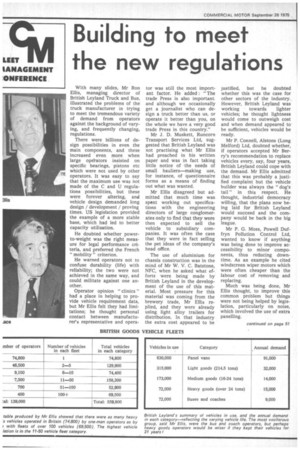Building to meet the new regulations
Page 48

If you've noticed an error in this article please click here to report it so we can fix it.
With many slides, Mr Ron Ellis, managing director of British Leyland Truck and Bus, illustrated the problems of the truck manufacturer in trying to meet the tremendous variety of demand from operators against the background of varying, and frequently changing, regulations.
There were billions of design possibilities in even the main components, and these increased even more when large operators insisted on specific bearings, pistons etc which were not used by other operators. It was easy to say that the maximum use was not made of the C and U regulations possibilities, but these were forever altering, and vehicle design demanded long design / development / proving times. US legislation provided the example of a more stable base, which had led to better capacity utilisation.
He doubted whether powerto-weight was the right measure for legal performance criteria, and preferred the French " mobility" criterion.
He warned operators not to confuse durability (life) with reliability; the two were not achieved in the same way, and could militate against one another.
Operator opinion " clinics " had a place in helping to provide vehicle requirement data, but Mr Ellis felt they had limitations; he thought personal contact between manufacturer's representative and opera tor was still the most important factor. He added : "The trade Press is also important. and although we occasionally get a journalist who can design a truck better than us, or operate it better than you, on the whole we have a very good trade Press in this country," Mr J. D. Muskett, Runcorn Transport Services Ltd, suggested that British Leyland was not practising what Mr Ellis had preached in his written paper and was in fact taking little notice of the needs of small hauliers—making use, for instance, of questionnaire forms as a means of finding out what was wanted.
Mr Ellis disagreed but admitted that much time was spent working out specifications with the engineering directors of large conglomerates only to find that they were then expected to sell the vehicle to subsidiary companies. It was often the case that they were in fact selling the pet ideas of the company's head office.
The use of aluminium for chassis construction was in the mind of Mr W. V. C. Batstone, NFC, when he asked what efforts were being made by British Leyland in the development of the use of this material. Most pressure for this material was coming from the brewery trade, Mr Ellis replied, and they were already using light alloy trailers for distribution. In that industry the extra cost appeared to be justified, but he doubted whether this was the case for other sectors of the industry.. However, British Leyland was working towards lighter vehicles; he thought lightness would come to outweigh cost and when demand appeared to be sufficient, vehicles would be ready.
Mr P. Connell, Alstons (Long Melford) Ltd, doubted whether, if operators accepted Mr Berry's recommendation to replace vehicles every, say, four years, British Leyland could cope with the demand. Mr Ellis admitted that this was probably a justified complaint but the vehicle builder was always the "dog's tail" in this respect. He. thought, industrial democracy willing, that the plans now being laid for British Leyland would succeed and the company would be back in the big league, Mr P. G. Moss, Powell Duffryn Pollution Control Ltd, wanted to know if anything was being done to improve accessibility to minor components, thus reducing downtime. As an example he cited windscreen wiper motors which were often cheaper than the labour cost of removing and replacing.
Much was being done, Mr Ellis thought, to improve this common problem but things were not being helped by legislation, particularly on noise, which involved the use of extra panelling.




































































































